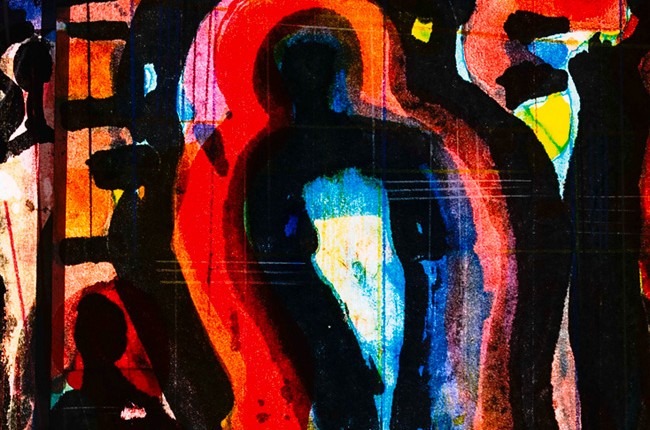Artists Share Their Thoughts
on Arts and Healing
. . .
As part of our June Arts and Healing focus with guest editor Gary Lemons, we asked a range of artists the questions that Gary proposed.
. . . . . – What is your concept of an art “community” for building creative alliances with individuals across different identities?
. . . . . – What are your thoughts about art as a creating form of inner healing and well-being?
As ever, we got a beautiful and moving array of responses for you to explore.
If you have thoughts to add, you can
email s.cowley@creativepinellas.org
. . .
Emily Stehle
. . .
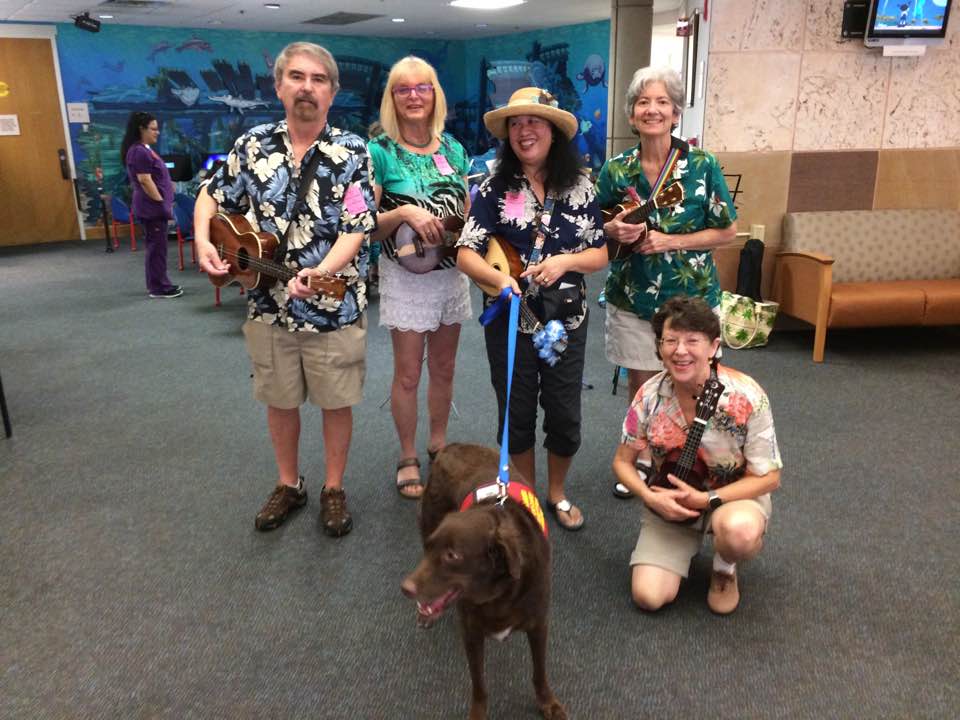
. . .
I’ve been struggling with how to express this because my thoughts sound too “new-agey” and touchy-feely!
But, of course, the arts – any form of creative art, performing arts – can be healing! As an unspoken form of communication, an artist can reveal thoughts and emotions through their work, while the viewer, the audience, receives and responds, or not.
My personal experience as a performing musician is that we founded a ukulele band called Ukers for Life for hospice patients/clients – a true example of how arts can heal. We knew that music (usually, depending on the type of music!) has a positive effect on the brain, producing a sense of well-being, endorphins, etc. for both the listener and the performer. We had read various studies and articles attesting to the healing power of music – one of the band members was a retired hospice nurse.
. . .
We visited our patients in their nursing home rooms for two years. These sessions have been cancelled for the past two years due to Covid.
To be honest, sometimes I dreaded going. Each visit was a 2-3-hour time commitment and I had other more “fun” things I wanted to do. Other times, I was out of sorts and felt sad as I knew our new “friends” were elderly and terminally ill. And we wouldn’t know if they were still alive since our last visit one or two weeks ago. But then, off we would go, knowing how they looked forward to our visits.
Once we began to sing their favorite songs and play our ukuleles they would sing or hum along, tap their feet or clap their hands, many with eyes closed. We felt their happiness of past memories, an affirmation of their lives. Each visit became joyful, yet bittersweet.
As a visual artist, I find creating art healing for me, offering an outlet for communicating thoughts that I wouldn’t normally express. I’m a public writer, a trained journalist by profession – taught to be objective and to tell the story of who, what, where, when (and sometimes) why.
. . .

. . .
My theme for my Emerging Artist project in 2020-21 was my response to the pandemic. As my first public art work, I decided to show what gave me and my family comfort during the first terrible, tragic year of Covid-19. Forty-one weeks translated into 41 Covid Comfort Baskets created from consumable products – food, items, music, my cat’s favorite food – that made us feel better.
The other component of my installation was to show three emotions we experienced during that time. I completed one of the three woven paper wall hangings planned for the exhibit – Ms. Blue, which represented calm and serenity. Still to come – Ms. Red for anger and Ms. Black for despair.
My photo is of a sub-group of the 41 Covid baskets of comfort music. They were woven from sheet musics of my favorite songs I played on my ukulele during my 2020 100 Days of Ukulele Songs Facebook project.
My comfort baskets gave others comfort as well. Nine were purchased during the Creative Pinellas show by folks who identified with a particular basket.
facebook.com/thehappiestrabbit
. . .
Amber DiPietra
. . .
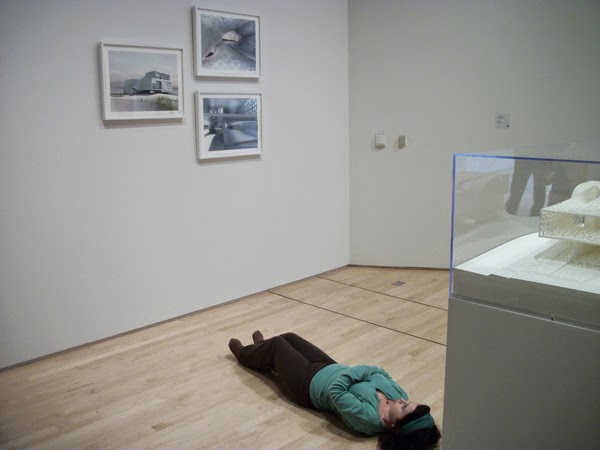
. . .
Art is the work and pleasure of imagining. The art cannot take form unless you can imagine it. In taking form, it is also a kind of embodiment.
Embodiment also means how you move in and through your body, how your body feels to you (heavy, light, etc), emotions around your body, body image, etc. The work of imagining can heal and uplift the physical body. Imagination and embodiment exist along the same continuum.
Much of my work as an artist takes the shape of co-created conversations and spaces for healing. It includes journaling, mindfulness practice, visualization practice and bodywork. The practice with individuals is my art – the poems or the performances, afterwards.
I am disabled/chronically ill and so this work is for that community, towards the more solid, vibrant appearance in society.
. . .
Bob Barancik
. . .

. . .
Here is a link to my extensive “Healing Through Art” website.
. . .
creativeshare.com/exhibits
You can download a PDF of Lamentations and Beyond: Healing Through Art
. . .
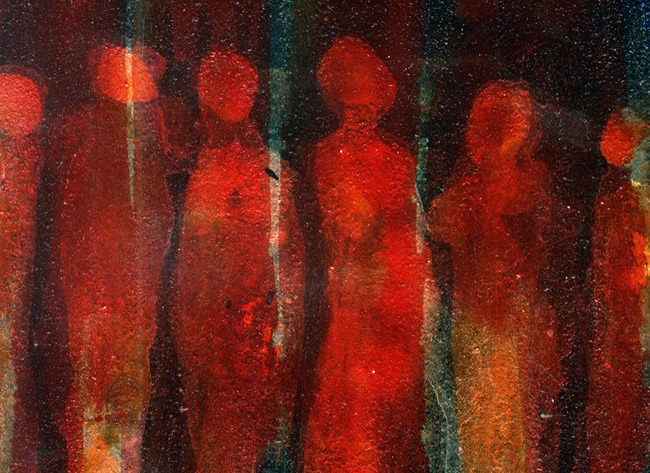
. . .
The poetry readings by my two favorite actresses, Mimi Rice and Roxanne Fay, meant a lot me.
. . .
Roxanne Fay reads Bob Barancik’s “Aging Haiku” here and “Visual Haiku” here
Mimi Rice reads “Curious Rhymes for Precarious Times” here, set to Bob’s visual imagery
. . .
I’ll also share this story – “Trial, Triumph, and the Art of the Possible: The Remarkable Story Behind Beethoven’s ‘Ode to Joy,’” published in The Marginalian. “A hymn of rage, a hymn of redemption, and a timeless love letter to the possible.” Perhaps no human being ever transcended genuine despair through art more than Beethoven.
. . .
Rose Marie Prins
. . .

. . .
One Sunday afternoon in early April, at the request of the Women’s Caucus for Art President, I gave a presentation to the members of the Florida Chapter of the Women’s Caucus for Art. This was our first in-person meeting since the start of the pandemic. It was held in the Chihuly Collection’s garden in downtown St Petersburg.
My presentation was titled “The Healing Power of Art.” Below is a partial transcript. I ended with a description of my personal experience with the healing power of art after my son Jaro died. To honor his memory as well as to help heal my broken heart, I published a book of his poems, A Leaf in the Wind: Poems by Jaro Majer, Artwork by Rose Marie Prins.
In 2009 Creative Clay established an arts in healthcare program, Creative Care. I was one of the first creatives to be invited to join the team. As part of our training, we visited the University of Florida’s Shands Hospital in Gainesville to observe their well-established Arts in Medicine program. We also spent a weekend of intensive training at the Franciscan Center in Tampa.
Then we, visual artists, writers, musicians and dancers, worked with patients and their families at Ronald McDonald House, All Children’s Hospital, St Anthony’s Hospital and Benedict Haven.
In the hospitals we worked in the oncology, infusion, psychiatric and post-operation wards. We worked bedside with individual patients, also groups of patients and family members and occasionally, groups of staff and volunteers. The reasons why art in healthcare works are numerous and there’s an excellent video on the Shand’s Arts in Medicine website that enumerates them. To sum them up – in situations where one is confronted by one’s own mortality, creativity is life affirming.
. . .
Some of the images patients made with me at All Children’s Hospital and St Anthony’s Hospital are available on greeting cards at Creative Clay in St Pete. Over and over people told me, “You made my day!”
The children in Infusion at All Children’s Hospital would ask the nurses to send me to their booth. When I arrived, their eyes would light up. Sometimes I was called upon to use art-making to distract a suffering child. I was amazed at how quickly tears could change to smiles.
During my time working at St Anthony’s Hospital a few artists-in-healthcare-in-training shadowed me. One of these was Debra Walling who later, after her mother passed away, published a book, Tending to My Wounds: Coping with Grief One Square at a Time and the companion workbook, Healing Through Art. Debra told me that her book, “came to be because eventually in grief there needs to be. . . closure. . . the book is where I found closure on my grief from my mother’s death.”
One memorable interaction I had was with a patient at St Anthony’s Hospital. The patient knew that his illness was terminal and he asked me to work with him to make a card for his wife. I taught him how to draw a simple rose and he did the rest, writing a message in the card to his wife about his deep love for her. Months later, after he had passed away, I received a note from her sent through the hospital staff. In it she told me how much that card meant to her, that it remains on her desk as a reminder of their love.
. . .

. . .
Eventually, because of funding cuts, etc., I was the only artist left of our original Creative Care team. I worked exclusively at St Anthony’s Hospital until the start of the pandemic.
Earlier this year I received the following communication from my supervisor at the hospital, the nun who is Vice President of Mission Integration –
“I can’t thank you enough for sharing your expertise, experience and compassion with us and our patients. You certainly played an important part in the healing of the whole person for many of our patients that you encountered. It was a shame, for just when the need for your services was was even greater during Covid, we had to close the hospital to all but essential Team Members. . . Thank you for being such a blessing to St. Anthony’s. . . You have displayed for us the important value of Art in the Healing process.”
In 2016 my son died suddenly and I came to learn first-hand the value of art in the healing process. After giving grief the time it needed, as Debra Walling put it, I too, published a book.
rosemarieprins.com
Instagram @prinsrosemarie
. . .
Steven Kenny
. . .

. . .
In one way or another, all my paintings are self-referential. I use myself as the raw material for my work. Each piece is a meditation on my personal development. They can be related to either my emotional or psychological state at the time as well as investigations into understanding my place in the world.
Looking back over my 38-year career, I can say that I’ve never set out intentionally to resolve any particular issue. Instead, I try to dredge up subconscious aspects of my psyche without judgement and compose visual metaphors for what I’m experiencing at a particular moment. Many times, it’s only in retrospect that I can see exactly what I was going through when I created the work. In this way, understanding who I WAS helps me better understand who I AM now. This perspective allows me to clearly see previous ways of unhelpful behavior or thinking, acknowledge those that didn’t serve me well, and choose more beneficial ways to move forward.
There has been one surprising and rewarding consequence of not consciously trying to address or heal particular personal issues through my images. By intending not to create didactic visual resolutions, viewers of my paintings very often find deep personal connections to their own lives in what they see. I’m often amazed to hear how my work resonates with the public in ways that I never intended.
For example, at the time that I painted The Fracture, I was going through a difficult stage in my life and thinking about how renewal springs from upheaval. More than one person asked if the image had anything to do with breast cancer. They revealed to me that breast cancer had deeply touched their lives and the painting provided a degree of reassurance and hope.
. . .
Ketsy Ruiz
. . .
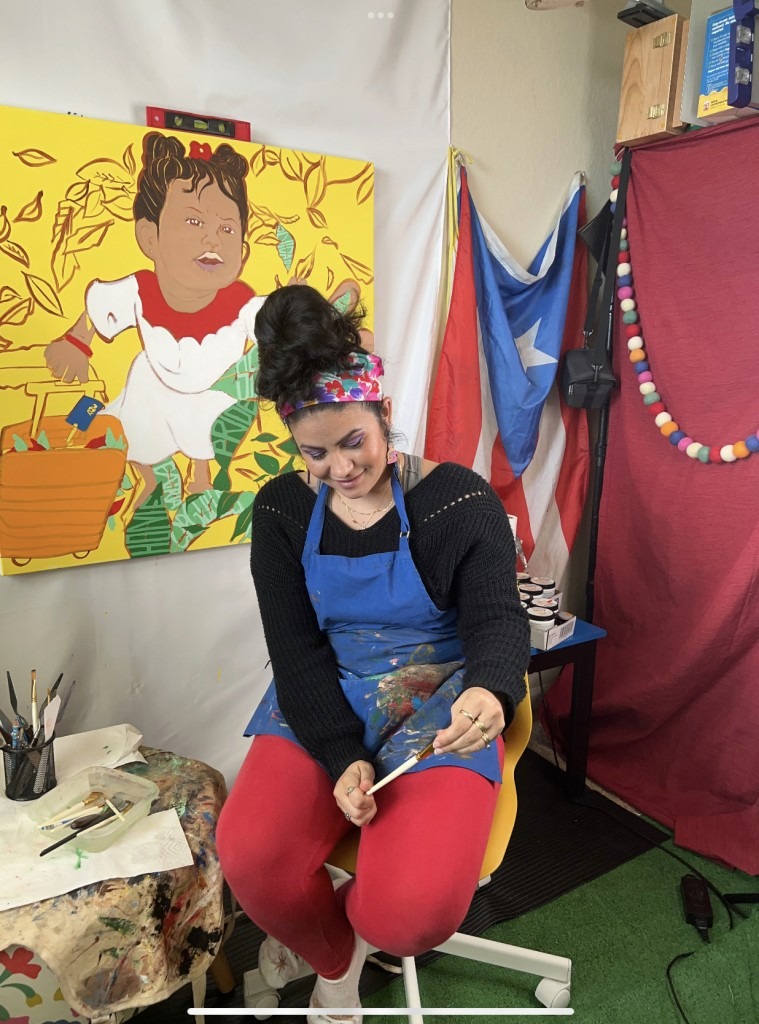
. . .
Rarely are there individuals being creative on their own without the influence or involvement of peer groups. Many creatives seek liked-minded creatives. Several kinds of art communities exist under the umbrella and outreach is the biggest part of building alliances amongst different creative communities.
Ideally, I would love to see bi-yearly events held online and in-person for all art collectives, studios, organizations, etc. in one county where they are all recognized for their contributions to the spaces they uplift. It also gives them a space to network and build these alliances with one another.
. . .
The process of creating is whole heartedly a way to heal and a form of self care for me. It’s the equivalent to journaling, meditation, reflection. It creates positive habit-forming reenforcement. It’s soul searching and therapy all in one.
Nothing makes me feel more purposeful and calm as a studio day full of research, sketching or painting. I get to tell my personal stories and my community’s narratives through my work and we get to heal together when the work is in process and when it’s complete. We feel seen together through the work.
Other artists’ work does the same for me. It makes me feel good when I see something that speaks to me. Art can say you aren’t alone, it can validate you, and it can uplift you.
. . .
Heather Rippert
. . .

. . .
I wanted to share my thoughts and direct experiences of how art heals. Everything I have done for the 2022 Emerging Artist Exhibit (on view through June 26) is related to this topic.
Art gives access to the unspoken realms. Art is a gateway to our hearts and souls and gives voice to things that are deep within us. For me personally, the action of creating a six painting series for me, my Dad and Kellie (who both passed away in 2020 four months apart), has been cathartic. To have honored my Dad, Hank Rippert, my best friend, Kellie Ricks, and myself, as well as the love I shared with each of them, has been a gift to my heart and soul and to theirs. I am left with a profound sense of peace since completing this series.
. . .
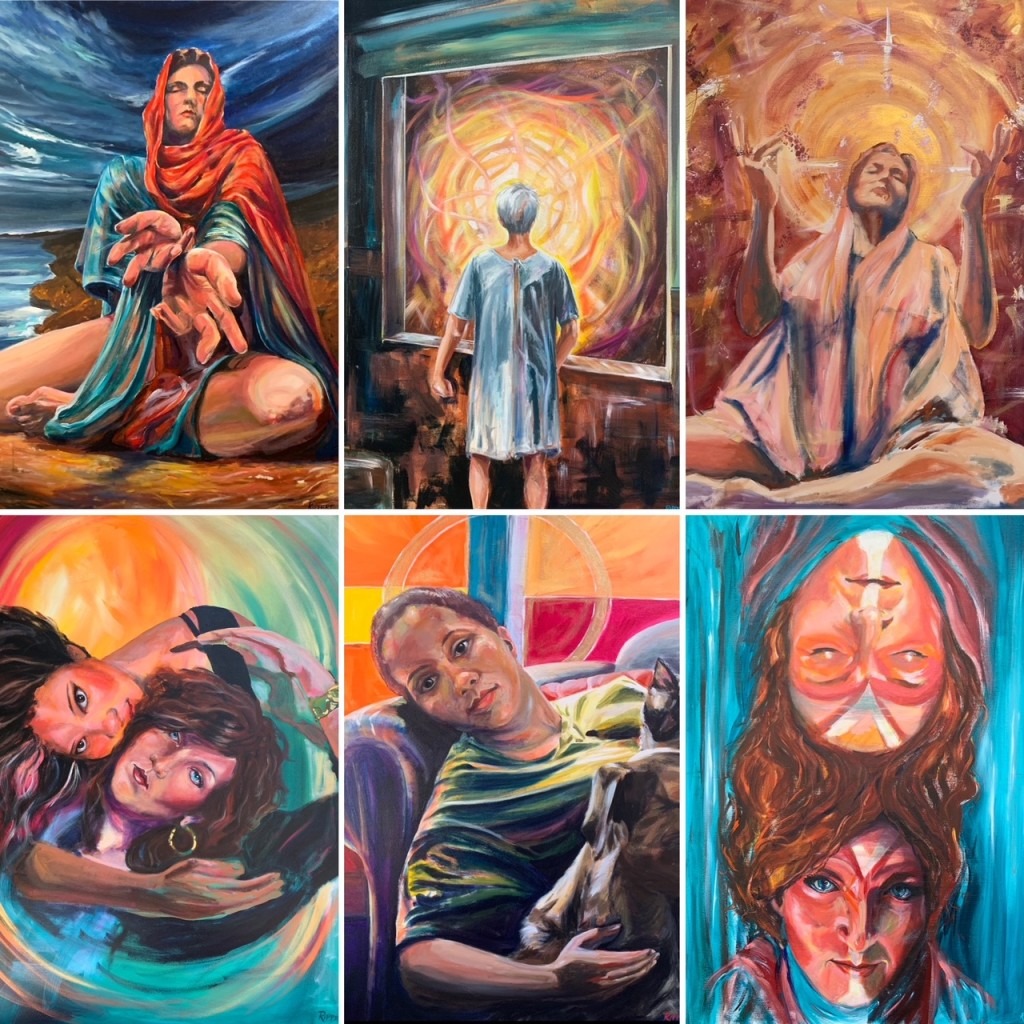
. . .
In the words of a dear friend, “Your paintings are tender and powerful love letters. It is a privilege to ‘read’ them + bear witness.” She also said they are “your heart made visible”.
Healing is possible through art and the act of creating. It can be healing for the creator and the viewer. I am living proof.
. . .
Christina Bertsos
. . .
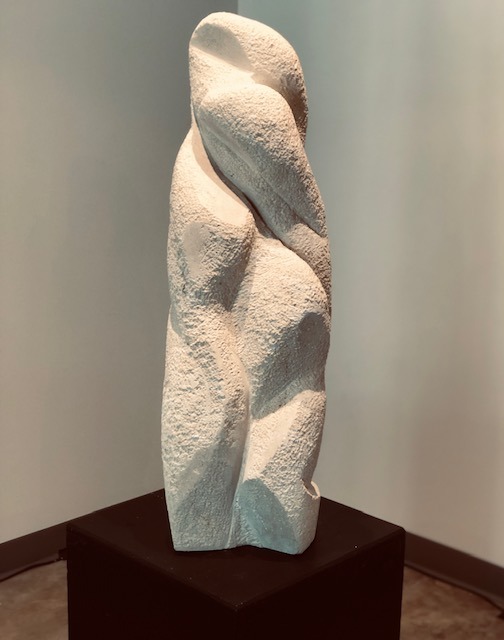
. . .
As an artist and someone who has worked in the medical field for 30 years, this is a subject very close to me. I have often asked myself the question, “What heals?” And I have been fortunate to be able to turn to art on many occasions to look for the answer.
When I am engrossed in making a piece of art, it is a form of meditation where reflection can take place. It allows me to step away from the event or condition and look at it, which often leads to a new understanding or acceptance. It also allows me to “do something” in situations where nothing can actually be done to change the outcome such as the death of a loved one.
It has been helpful to dedicate a piece of art to a loved one and imagine I am giving it to them as a gift. But what I have come to realize is that the gift I am giving is actually to myself, as if to say “it’s all going to be okay”. And in that acceptance, I begin to heal.
On the level of healing many people or healing society, art in the form of memorials is hugely powerful. The Vietnam Veteran’s Wall by Maya Lin comes to mind. They can be small or very big but the art itself represents an act of love.
These acts help people cope and ultimately reach for healing. Healing happens on the level of the heart. Once the heart can mend, even a tiny bit, a shift in the emotional and physical begins to take place.
We don’t really know exactly what heals but my sense is that it goes beyond just the doctor’s prescription. And art can be a very powerful remedy.
. . .
Lynn Whitelaw
. . .
When I think of Arts and Healing, I remember back to the 1990s when I had interactions as Curator of Education at the Tampa Museum of Art with Barbara Kazanis, who was director of the Art Education Department at USF and taught courses in art therapy.
In the 1990s, she assisted the Tampa Museum of Art in setting up an art therapy program with The Spring for abused children. I was very proud of that program but could not publicize it because of the need for anonymity.
She and I also worked on a powerful exhibition at TMA entitled Children and War: Memories of my Childhood in Croatia based on the principles of a Croatian art therapist who worked with displaced children during that conflict. We put the children’s artwork on foam core with raised backings so they could be mounted to float on the spotlighted purple walls done in groupings. I keep two works as a reminder in one of my bookcases.
I remember Barbara also conducting an art therapy program at an office building on Rocky Pointe after a workplace shooting took place there – to me it was the first time I saw art therapy being recognized for its power to heal.
Barbara Kazanis was an important early proponent of art therapy in this area, and she sent many programs and therapists in that direction.
. . .
For me, I have continued to be a strong supporter for the power of art therapy programs and was able to develop that interest at the Leepa-Rattner Museum of Art in Tarpon Springs. We had an active art therapy program that we ran for many years (maybe 18?) working with agencies like the Chi Chi Rodriguez Youth Foundation and Pace Center for Girls.
Early on we received a grant from the Pinellas Arts Council to host an Art Therapy Symposium held at LRMA that brought together literary, performing and visual art therapists – it was very successful. Over the year the LRMA program was fortunate to find funding to have licensed art therapists (Lin Carte, now deceased, and MaryAnn Hamilton, who is still active in the art therapy community and can be contacted at artxham@yahoo.com) conduct our therapy sessions – COVID brought and end to that, unfortunately.
Robin Saenger’s Peace4Tarpon.org in Tarpon springs is a national model for creating a “trauma-informed community” that uses art therapy as one of its important tools. And Diane Woods, director of Tarpon Arts, the cultural affairs office for the City of Tarpon Springs, recently held The Art of Health as a community event that also included topics of art and healing.
Art therapy and its power for healing is now needed more than it ever has.
registrytampabay.com/an-interview-with-museum-curator-lynn-whitelaw
. . .
Barbara Kazanis
. . .

. . .
Lynn Whitelaw asked me to mount an exhibition of the art of Children and War at the Tampa Museum of Art. This was during the Balkan wars. I was invited to curate it, for the International Group of the American Psychological Association. APA was pairing with individual psychologists, counselors and teachers to help support and share information on trauma knowledge and programs here in the states.
One of those supports was a public health psychologist who worked with psychologist Árpád Baráth, who worked with Croatian children with PTSD. Funded in part by UNESCO, with a good deal of work published in Children of War‘s publication, this became an international public health model.
Later it was developed into a model of community trauma intervention through local libraries. The libraries included cultural and arts programs. Thus it was a unique but amazing public health community-based program for trauma.
Here in the states, schools and social programs were newly defining trauma and its effects on children at this time. Education was in the early stages of understanding violence in the schools. This program was a complete educational intervention model for trauma and community healing.
In our exhibition, the audience walked through the Seven Step program. The children’s artwork and writing, poetry and paintings, were direct and powerful, hung in chapel-like lighting with deep respect.
One consultant described her eyes as a therapist as viewing wounded Hope.
. . .

. . .
We who created the exhibit found ourselves with the challenge of trauma – can we believe this is an essentially human universe? A community question seen right now in the Uvalde school shooting and that applies to all of us.
The knowledge-based ideas at the early roots of our now flowering programs came from my deep studies of new directions and practices of healing, art, ritual, myth, body, somatic field and therapies, Jungian psychology and inner dialogue processes.
As Lynn and I reminisced we realized that I may have been the original spark point for the entire history of art therapy in the area, as USF was the only source of education at the graduate level and served a five county area.
My first graduate students were the first several directors of the newly-formed Dunedin Art Center, and we all grew together.
We were the ones who in an interdisciplinary professionals community group, created at least five years of conferences that began what we called the healing arts in Tampa Bay in the early ’80s.
USF Performing Arts-Medicine Collaborative
Florida Art Therapy Association
. . .
Carol Mickett and Robert Stackhouse
. . .
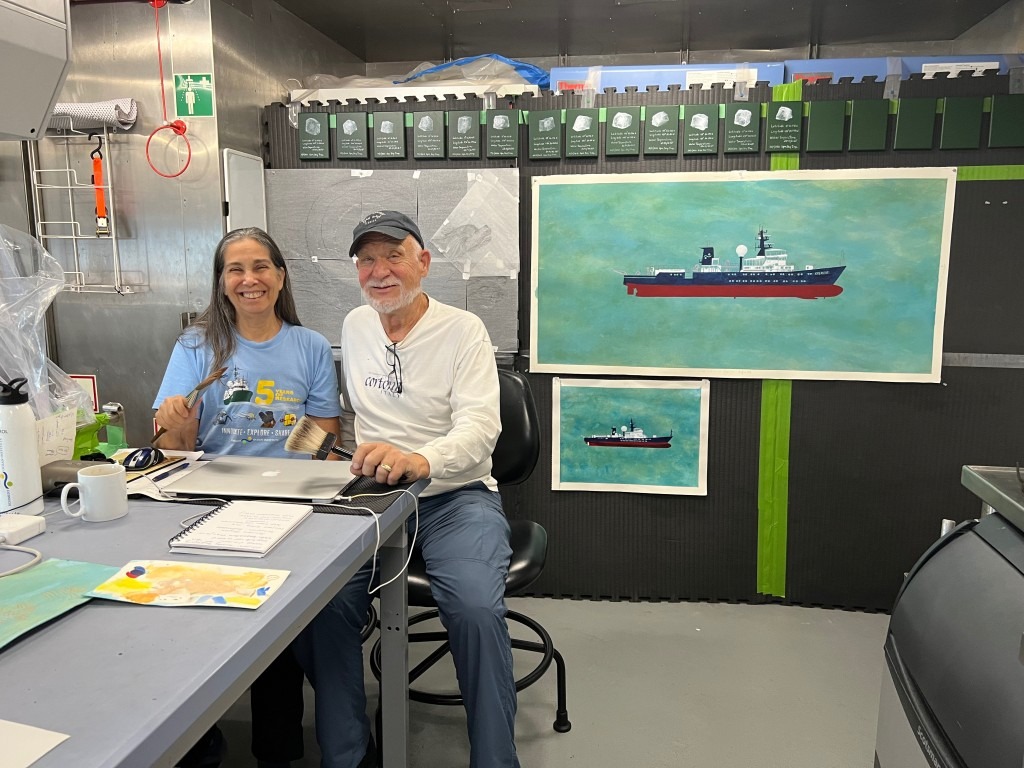
. . .
Why do we look so happy? The answer is simple. We are in “our studio.” It happens to be aboard the Schmidt Ocean Institute’s research vessel Falkor, but it could just as well be in our studio in Tarpon Springs, Pinellas County.
The key is that we are engaged in being creative. Where we do this is not really the point. The key is doing it! There is a great joy in discovery and making art.
Now, I have to say that such joy is not possessed by artists alone. Creative people across the board experience this – mathematicians, scientists, chefs, gardeners, and the list goes on.
As an artist, as in most of life, to find joy requires us to get past the things that block us from action. Mostly it’s fear. Fear of failure. Fear of embarrassing ourselves. Fear of it not being any good.
But what I have learned is that making failures, embarrassing works, or things that are just not good are often the things that lead me to the best art I make. Doing is the key.
Art On!
facebook.com/MickettStackhouseStudio
. . .. . .
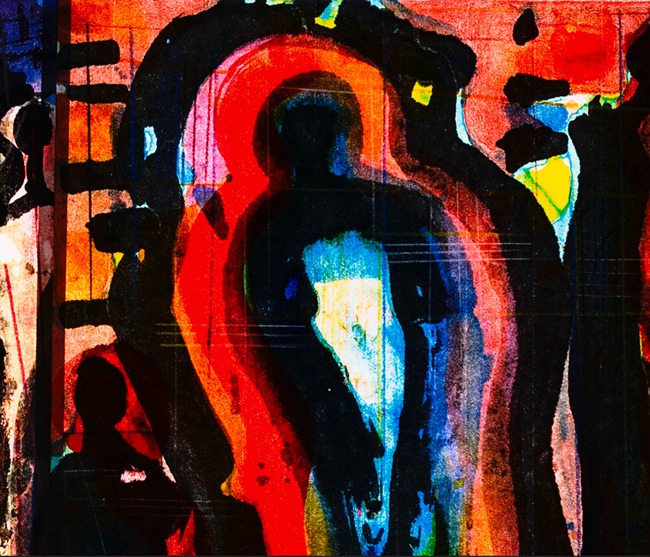
. . ..
